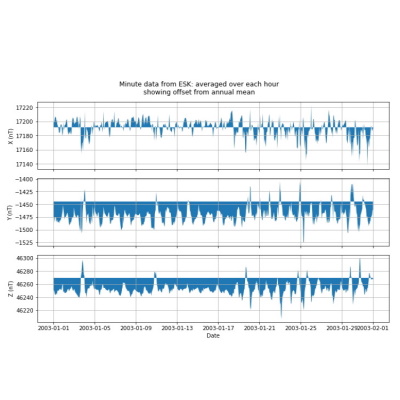- News
- International Association of G...
International Association of Geomagnetism and Aeronomy IAGA Schools
14 Oct 2021
Every two years, alongside its Scientific Assemblies, the International Association of Geomagnetism and Aeronomy (IAGA) runs schools to provide excellent early career scientists with a good basic understanding of the wide range of topics covered by IAGA science. The 5th IAGA School was held in virtual form from 16-20 August 2021, preceding the Joint IAGA-IASPEI Scientific Assembly. International experts in their fields gave lectures to 35 PhD students from all over the globe.
The 3-satellite Swarm constellation figured prominently in lectures on geomagnetic observations and field modelling. The Swarm instrumentation and techniques for magnetometer calibration in space were described, along with modern ground-based magnetic observatory practice as promoted by INTERMAGNET. The state-of-the-art comprehensive modelling approach, using Swarm data to derive models of the core magnetic field and its changes with time, simultaneously with models of the ionospheric, magnetospheric, crustal and ocean induction fields was described. The ocean induction results showed how well a low-amplitude tidally-driven signal can be recovered from Swarm data by this approach to separating signals from the different sources – a considerable achievement.
Follow-on practical sessions based on Python and Jupyter notebooks were carried out using the VirES/VRE platform. The notebooks included explanatory text, relevant equations and code, allowing the students to experiment with inputs and see immediate displays of outputs. Students were led from simple exploration of the behaviour of the Earth’s magnetic field using ground-based observatory data, through the mathematics of global magnetic field modelling, to finally producing a global magnetic field model using a Swarm dataset. VirES provided convenient access to data from Swarm as well as INTERMAGNET observatories. Figure 1 is an example of a plot from a magnetic observatory revealing the effects of both internal and external geomagnetic field sources on the recordings. Figure 2 is an example helping students to visualise the mathematical ‘building blocks’ used in global geomagnetic field modelling, and Figure 3 is a map of the vertical magnetic field calculated from a global magnetic field model derived using Swarm data.



The Jupyter notebooks are now included in the online textbook as a resource for all researchers. Their use in the IAGA School is an excellent example of how Swarm products and services are playing an important role in educating the next generation of geoscientists.
For more information on past and future IAGA Schools visit the IAGA web-site